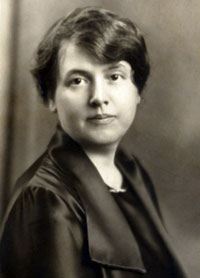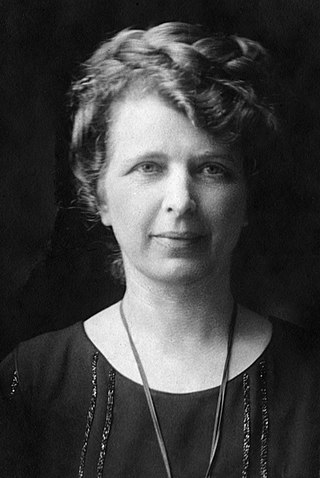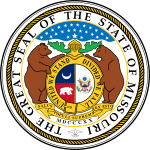
The League of Women Voters (LWV) is an American nonprofit, nonpartisan political organization. Founded in 1920, its ongoing major activities include registering voters, providing voter information, and advocating for voting rights. In addition, the LWV works with partners that share its positions and supports a variety of progressive public policy positions, including campaign finance reform, women's rights, health care reform, gun control and LGBT+ rights.

Carrie Chapman Catt was an American women's suffrage leader who campaigned for the Nineteenth Amendment to the United States Constitution, which gave U.S. women the right to vote in 1920. Catt served as president of the National American Woman Suffrage Association from 1900 to 1904 and 1915 to 1920. She founded the League of Women Voters in 1920 and the International Woman Suffrage Alliance in 1904, which was later named International Alliance of Women. She "led an army of voteless women in 1919 to pressure Congress to pass the constitutional amendment giving them the right to vote and convinced state legislatures to ratify it in 1920". She "was one of the best-known women in the United States in the first half of the twentieth century and was on all lists of famous American women."
The 1916 Democratic National Convention was held at the St. Louis Coliseum in St. Louis, Missouri from June 14 to June 16, 1916. It resulted in the nomination of President Woodrow Wilson and Vice President Thomas R. Marshall for reelection.

Emma Smith DeVoe was an American women suffragist in the early twentieth century, changing the face of politics for both women and men alike. When she died, the Tacoma News Tribune called her Washington state's "Mother of Women's Suffrage".

Minnie Fisher Cunningham was an American suffrage politician, who was the first executive secretary of the League of Women Voters, and worked for the passage of the Nineteenth Amendment to the United States Constitution giving women the vote. A political worker with liberal views, she became one of the founding members of the Woman's National Democratic Club. In her position overseeing the club's finances, she assisted in the organization's purchase of its Washington, D.C. headquarters, which is still in use.

Edna Fischel Gellhorn was an American suffragist and reformer who helped found the League of Women Voters.

The League of Women Voters of Florida (LWVFL) is a civic organization in the state of Florida. The organization is nonpartisan; the League's Bylaws mandate that the organization will not support any political candidate or party. League promotes political responsibility through informed and active participation of citizens in government, acts on selected governmental issues, and influences public policy through education and advocacy. League's members do advocate on policy issues.

Women's suffrage was established in the United States on a full or partial basis by various towns, counties, states, and territories during the latter decades of the 19th century and early part of the 20th century. As women received the right to vote in some places, they began running for public office and gaining positions as school board members, county clerks, state legislators, judges, and, in the case of Jeannette Rankin, as a member of Congress.

The Dallas Equal Suffrage Association (DESA) was an organization formed in Dallas, Texas in 1913 to support the cause of women's suffrage in Texas. DESA was different from many other suffrage organizations in the United States in that it adopted a campaign which matched the social expectations of Dallas at the time. Members of DESA were very aware of the risk of having women's suffrage "dismissed as 'unladylike' and generally disreputable." DESA "took care to project an appropriate public image." Many members used their status as mothers in order to tie together the ideas of motherhood and suffrage in the minds of voters. The second president of DESA, Erwin Armstrong, also affirmed that women were not trying to be unfeminine, stating at an address at a 1914 Suffrage convention that "women are in no way trying to usurp the powers of men, or by any means striving to wrench from man the divine right to rule." The organization also helped smaller, nearby towns to create their own suffrage campaigns. DESA was primarily committed to securing the vote for white women, deliberately ignoring African American women in the process. Their defense of ignoring black voters was justified by having a policy of working towards "only one social reform at a time."

The Texas Equal Suffrage Association (TESA) was an organization founded in 1903 to support white women's suffrage in Texas. It was originally formed under the name of the Texas Woman Suffrage Association (TWSA) and later renamed in 1916. TESA did allow men to join. TESA did not allow black women as members, because at the time to do so would have been "political suicide." The El Paso Colored Woman's Club applied for TESA membership in 1918, but the issue was deflected and ended up going nowhere. TESA focused most of their efforts on securing the passage of the federal amendment for women's right to vote. The organization also became the state chapter of the National American Woman Suffrage Association (NAWSA). After women earned the right to vote, TESA reformed as the Texas League of Women Voters.

The St. Louis Equal Suffrage League was formed in 1910 in St. Louis, Missouri with the aim of "bring[ing] together men and women who are willing to consider the question of Equal Suffrage and by earnest co-operation to secure its establishment."

This is a timeline of women's suffrage in Missouri. Women's suffrage in Missouri started in earnest after the Civil War. In 1867, one of the first women's suffrage groups in the U.S. was formed, called the Woman Suffrage Association of Missouri. Suffragists in Missouri held conventions, lobbied the Missouri General Assembly and challenged the Supreme Court of the United States (SCOTUS). The case that went to SCOTUS in 1874, Minor v. Happersett was not ruled in the suffragists' favor. Instead of challenging the courts for suffrage, Missouri suffragists continued to lobby for changes in legislation. In April 1919, they gained the right to vote in presidential elections. On July 3, 1919, Missouri becomes the eleventh state to ratify the Nineteenth Amendment.

The women's suffrage movement was active in Missouri mostly after the Civil War. There were significant developments in the St. Louis area, though groups and organized activity took place throughout the state. An early suffrage group, the Woman Suffrage Association of Missouri, was formed in 1867, attracting the attention of Susan B. Anthony and leading to news items around the state. This group, the first of its kind, lobbied the Missouri General Assembly for women's suffrage and established conventions. In the early 1870s, many women voted or registered to vote as an act of civil disobedience. The suffragist Virginia Minor was one of these women when she tried to register to vote on October 15, 1872. She and her husband, Francis Minor, sued, leading to a Supreme Court case that asserted the Fourteenth Amendment granted women the right to vote. The case, Minor v. Happersett, was decided against the Minors and led suffragists in the country to pursue legislative means to grant women suffrage.

The first women's suffrage effort in Florida was led by Ella C. Chamberlain in the early 1890s. Chamberlain began writing a women's suffrage news column, started a mixed-gender women's suffrage group and organized conventions in Florida.

This is a timeline of women's suffrage in Arkansas. Early suffrage efforts date back to 1868 when Miles Ledford Langley tries to add a women's suffrage law in the state constitutional convention. The first women's suffrage organization in the state was created by Lizzie Dorman Fyler in 1881 and lasts until 1885. Another suffrage group is started in 1888 by Clara McDiarmid. Women's suffrage work continues steadily, though slowed down until the 1910s. New suffrage organizations began to form and campaigned for women's suffrage legislation. In 1917, women earned the right to vote in state primary elections. In May 1918 between 40,000 and 50,000 voted for the first time in Arkansas' primaries. On July 28, 1919 Arkansas ratified the Nineteenth Amendment. On December 3, 1919 the League of Women Voters (LWV) of Arkansas was formed.

In 1893, Colorado became the second state in the United States to grant women's suffrage and the first to do so through a voter referendum. Even while Colorado was a territory, lawmakers and other leaders tried to include women's suffrage in laws and later in the state constitution. The constitution did give women the right to vote in school board elections. The first voter referendum campaign was held in 1877. The Woman Suffrage Association of Colorado worked to encourage people to vote yes. Nationally-known suffragists, such as Susan B. Anthony and Lucy Stone spoke alongside Colorado's own Alida Avery around the state. Despite the efforts to influence voters, the referendum failed. Suffragists continued to grow support for women's right to vote. They exercised their right to vote in school board elections and ran for office. In 1893, another campaign for women's suffrage took place. Both Black and white suffragists worked to influence voters, gave speeches, and turned out on election day in a last-minute push. The effort was successful and women earned equal suffrage. In 1894, Colorado again made history by electing three women to the Colorado house of representatives. After gaining the right to vote, Colorado women continued to fight for suffrage in other states. Some women became members of the Congressional Union (CU) and pushed for a federal suffrage amendment. Colorado women also used their right to vote to pass reforms in the state and to support women candidates.

The League of Women Voters of California is a non-partisan organization that is part of the national League of Women Voters. Founded by Carrie Chapman Catt in the 1920s, The league was formed from the National American Women's Suffrage Association. Their stated goals are to encourage "informed and active participation in government," "increase understanding of major public policy issues," and influence "public policy through education and advocacy." The league has over 65 county groups within the state.
The National Council of Women Voters, founded in 1911, was a nonpartisan organization intended to educate women voters and support the suffrage movement. The council was founded by Emma Smith DeVoe. At the 1909 conference of the National American Women's Suffrage Association (NAWSA), DeVoe proposed the formation of a national organization for women in states where they had voting rights. She envisioned this being an organization not only to advocate for women who could vote at the state level, but to eventually succeed NAWSA once suffrage was settled law. The motion was voted down, so DeVoe formed her own coalition. In 1919, a national convention of NCWV and NAWSA voted to merge the two organizations. The merger was made official in early 1920, resulting in the formation of the League of Women Voters.

The League of Women Voters of Alabama (LWVAL) is a nonpartisan civic and political organization in the state of Alabama. The mission of LWAL is to encourage informed and active participation in government, and to influence public policy through education and advocacy. Like other state arms of the league, it is affiliated to the national League of Women Voters.


















